
Martin Parr
Finding Humor in Humanity
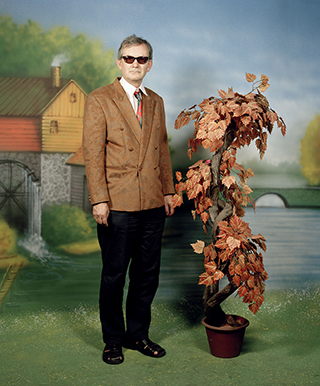
Martin Parr Collection.
SINGAPORE. New Ming Chun
Photo Studio. Autoportrait. 2007
Self-proclaimed workaholic Martin Parr has produced more than 80 books and contributed toward 300+ exhibitions over the course of 31 years. Much of his work is known for the whimsy found in everyday life. Parr has an eye for the funny side of life. He finds those intersections in time which bring together personalities, circumstances, image framing, light, and color. That equation has defined his unique style. Martin’s observations clearly state two principals to the observer: 1) Look at what you are missing, because you perhaps are too busy to see this side of life. 2) There is more to life than the human preoccupation with trials and difficulties.
A third element adds to the Parr connotation. Studio assistant Jenni Smith summarizes, “People often ask us to “Parr it up”, and by that they mean to add contrast and saturation. That is an adjective which describes the look. In actuality, we produce images which are accurate to the camera data. The garish look that people associate Martin with comes from the days of using cheap amateur film combined with using a macro lens and ring flash.”
Jenni went on to say, “It is a common request on advertising shoots that we are asked to “Parr the shot up”. I don’t think that Martin necessarily wants exaggerated color, but he is drawn towards shooting colorful scenes. We, in fact, try to reproduce the colors accurately.”
Of his sense of humor, Parr states, “I love it, record it, but there is a bit of mischief there too.” Using individuals as graphic elements, there is almost always a play on juxtaposition. Almost like a Magritte painting, the happenstance arrangement of people on a canvas seems both spontaneous - and unlikely. The fact that each of Parr’s photographs document a real moment in time, seems to say, “This actually occurred, but it looks like magic”. The observers pause. What is this? Viewers can not help but to pay attention to these marvelous images.
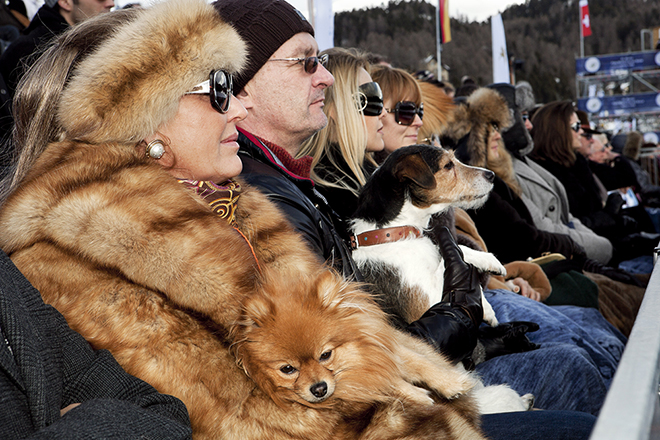
During a recent visit in Switzerland, Martin photographed one woman and her dog. The fact that the lady’s choice of winter fur collar matched the color of the dog’s fur - is not only startling, but also amusing.
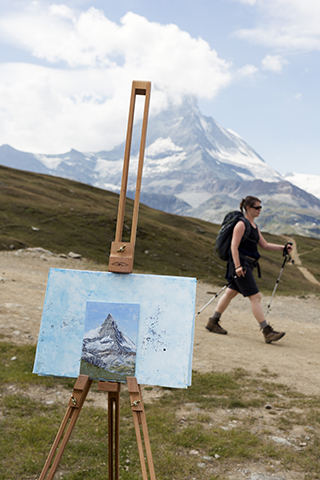
In another image, the iconic Matterhorn peak forms the backdrop for a play on the typical tourist photo. It uses geometry, image crop, and the human element to create a bit of visual competition. The viewer does not know what to make of the three elements which vie for attention: The mountain, a painting of the mountain, and a hiker walking out of the frame. This is perfection in illustrating the dictionary definition of “serendipity”.
The images are also a study of the quirky, the idiosyncratic, and the excess of the consumer focused western world. Parr states, “Life is weird! If only we could see it.” The compositions each make a comment on that theme. This is perhaps the driving force which attracts the viewer to study each of the photographs in detail. Many of the subtexts are sublime. Some are overt. They are always unique.
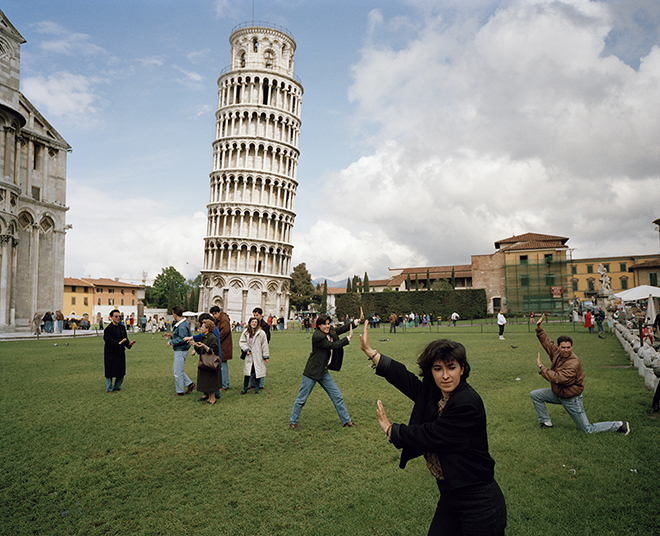
Parr is a photographer who photographs photographers. Tourists visiting iconic sites such as the Leaning Tower of Pisa or the Matterhorn make great subject matter. The “tourist photographers” have a relationship with their subjects, and the subjects in turn display a freedom to perform for the camera. Those performances then become the graphic elements for Martin’s study of human behavior. Whether holding up the leaning tower, or jumping in unison, the subjects serve as more than family or friends in a traveler’s snapshot. The relationship between the tourists and the magic of photography becomes a “plot within a plot”.
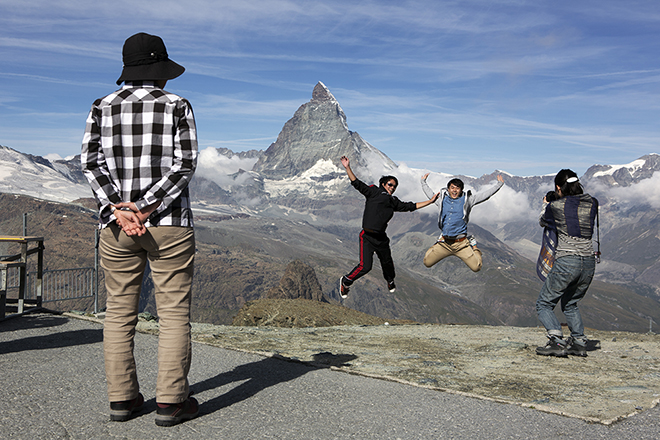
The body of work certainly has public attention. Two wide format printers were kept busy full time producing output for thirteen exhibitions in 2013. Jenni commented, “It is amazing how much work one man can produce.” Martin added, “I am a bit prolific. I can not help myself.”
“I have a show now in London at the Media Space. It is a new gallery of photography that opened in September. It is within the Science Museum. It is run by the National Media Museum, which is the old National Photography Museum.
I curated a Tony Ray-Jones show. He died very young at the age of 30. I went through all his negatives, which had been left at the museum in the archive. I found a whole set of new pictures, we showed that plus his famous pictures, plus a set of work which I had done during the 70s.”
Without taking a breath, Martin continues, “I do 2 or 3 books per year. I did Life is a Beach this year. I did something called the Black Country Magazine. Which is a zine for Women in the Black Country.
I am doing something in Birmingham in this run down area called the Black Country. I have been working there over four years. This will come to fruition with a show in October of 2014. Birmingham is a quite old industrial area. It is post industrial. It is economically a bit challenged.”
As if to emphasize that workaholic lifestyle, the discourse continues, “I have a book coming out on Paris next year. We are just preparing that book. The Museum of European Photography has commissioned me to do my take on Paris.
I am also doing a big project on Germany with the Sprengel Museum. And I am doing volume 3 of the photo book of history. That has just gone to press now.”
“I just have come back from Nigeria. I was doing a photography festival in Lagos. I also produced city life images while I was there. The traffic in Lagos is so bad that I made a point of street photography from the car. It is modern hybrid of old fashioned street photography and Google street views.
And so it goes on. I like to bring stuff out.”
This time, taking a moment to reflect on other activities, Martin mentions, “I am a visiting professor at the University of Ulster. It is enjoyable to see student’s work, and to see what they are up to.” Parr enjoys the mentoring process. He spent the previous eight years working with students at the University of Wales.
From that vantage as an observer and educator flows the talent in curating shows for notable creatives. Among the previous 17 shows, representative works include Ray-Jones, John Hinde Butlins, David Goldblatt, as well as many young talents.
While looked up to by many students and aspiring professionals, Parr himself is always observing, always learning.
Martin’s photographic experience is entirely immersive. It is a multi-sensory lifestyle. He surrounds himself with artifacts from the history of imaging. That personal collection of objects, post cards, photo books, and collected works has formed the basis for several shows, including Parrworld. Initially opened in 2008 at the Haus der Kunst in Munich Germany, demand for the show created a follow-on tour to other major European cities during the course of the next two years.
The obsession for finding the perfect image has driven Martin and his staff to constantly explore and improve the color workflow. Always fans of EIZO monitor technology, the ColorEdge CG246 especially attracts their admiration. “We have been using EIZO monitors for eight years and they have always been brilliant. Better still is our new CG246, because with the improved handling of colors, it helps us to see more accurate soft proofing. The colors in print are in closer agreement and the new level of accuracy helps us to achieve final prints with fewer tests.”
Jenni expanded on that. “We appreciate the wide viewing angle. Three of us can evaluate an image together now. This is especially critical as we produce a range of limited edition prints for Martin’s commercial galleries, along with important galleries and museums worldwide. This high level of accuracy also applies to our guide prints supplied to the book publishers. They are the benchmark references for color matching to the agreed exacting print quality.”
“The monitor holds calibration so well that it has become our studio reference. Our workflow has changed. We view all images on the CG246 before printing. Due to the high production demand, we are now adding a second CG246 to the group.”



